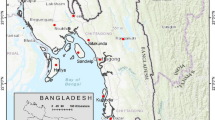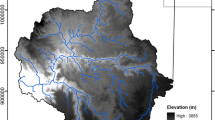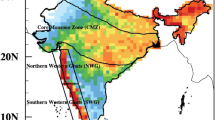Abstract
Climate is changing and evidence suggests that the impact of climate change would influence our everyday lives, including agriculture, built environment, energy management, food security and water resources. Brunei Darussalam located within the heart of Borneo will be affected both in terms of precipitation and temperature. Therefore, it is crucial to comprehend and assess how important climate indicators like temperature and precipitation are expected to vary in the future in order to minimise its impact. This study assesses the application of a statistical downscaling model (SDSM) for downscaling General Circulation Model (GCM) results for maximum and minimum temperatures along with precipitation in Brunei Darussalam. It investigates future climate changes based on numerous scenarios using Hadley Centre Coupled Model, version 3 (HadCM3), Canadian Earth System Model (CanESM2) and third-generation Coupled Global Climate Model (CGCM3) outputs. The SDSM outputs were improved with the implementation of bias correction and also using a monthly sub-model instead of an annual sub-model. The outcomes of this assessment show that monthly sub-model performed better than the annual sub-model. This study indicates a satisfactory applicability for generation of maximum temperatures, minimum temperatures and precipitation for future periods of 2017–2046 and 2047–2076. All considered models and the scenarios were consistent in predicting increasing trend of maximum temperature, increasing trend of minimum temperature and decreasing trend of precipitations. Maximum overall trend of Tmax was also observed for CanESM2 with Representative Concentration Pathways (RCP) 8.5 scenario. The increasing trend is 0.014 °C per year. Accordingly, by 2076, the highest prediction of average maximum temperatures is that it will increase by 1.4 °C. The same model predicts an increasing trend of Tmin of 0.004 °C per year, while the highest trend is seen under CGCM3-A2 scenario which is 0.009 °C per year. The highest change predicted for the Tmin is therefore 0.9 °C by 2076. The precipitation showed a maximum trend of decrease of 12.7 mm year. It is also seen in the output using CanESM2 data that precipitation will be more chaotic with some reaching 4800 mm per year and also producing low rainfall about 1800 mm per year. All GCMs considered are consistent in predicting it is very likely that Brunei is expected to experience more warming as well as less frequent precipitation events but with a possibility of intensified and drastically high rainfalls in the future.






Similar content being viewed by others
References
Bing Q, Jiahu J (2010) Analysis of trents of future temperature in the Bosten Lake Basin based on a statistical downscaling model. J Resour Ecol 1(3):268–273. doi:10.3969/j.issn.1674-764x.2010.03.011
CCDS (2014) HadCM3 predictors: A2(a) and B2(a) experiments. http://ccds-dscc.ec.gc.ca/?page=pred-hadcm3. Accessed 9 Mar 2016
Chien-ming C (2013) Enhanced accuracy of rainfall–runoff modeling with wavelet transform. J Hydroinf 15(2):392–404
Chu JT, Xia J, Xu CY, Singh VP (2010) Statistical downscaling of daily mean temperature, pan evaporation and precipitation for climate change scenarios in Haihe River. China Theor Appl Climatol 99(1):149–161. doi:10.1007/s00704-009-0129-6
Chua TE, Chou LM, Sadorra MSM (1987) The coastal environmental profile of Brunei Darussalam: resource assessment and management issues. Fisheries Department, Ministry of Development, Brunei Darussalam, pp 9–10
Duhan D, Pandey A (2015) Statistical downscaling of temperature using three techniques in the tons river basin in Central India. Theor Appl Climatol 121(3–4):605–622
Fowler HJ, Blenkinsop S, Tebaldi C (2007) Linking climate change modelling to impact studies: recent advances in downscaling techniques for hydrological modelling. Int J Climatol 27(12):1547–1578. doi:10.1002/joc.1556
Gagnon S, Singh B, Rousselle J, Roy L (2005) An application of the statistical downscaling model (SDSM) to simulate climatic data for streamflow modelling in Québec. Canadian Water Resources Journal 304(4):297–314. doi:10.4296/cwrj3004297
Goyal MK, Ojha CSP (2011) PLS regression-based pan evaporation and minimum–maximum temperature projections for an arid lake basin in India. Theor Appl Climatol 105:403. doi:10.1007/s00704-011-0406-z
Goyal MK, Burn DH, Ojha CSP (2012) Evaluation of machine learning tools as a statistical downscaling tool: temperatures projections for multi-stations for Thames River Basin, Canada. Theor Appl Climatol 108:519–534. doi:10.1007/s00704-011-0546-1
Goyal MK (2014) Monthly rainfall prediction using wavelet regression and neural network: an analysis of 1901–2002 data, Assam, India. Theor Appl Climatol 118:25. doi:10.1007/s00704-013-1029-3
Haddad K, Johnson F, Rahman A, Green J, Kuczera G (2015) Comparing three methods to form regions for design rainfall statistics: two case studies in Australia. J Hydrol 527:62–76
Hasan DSNABPA, Ratnayake U, Shams S (2016) Evaluation of rainfall and temperature trends in Brunei Darussalam. AIP Conference Proceeding 1705(1):020034. doi:10.1063/1.4940282
Hay LE, Clark MP (2003) Use of statistically and dynamically downscaled atmospheric model output for hydrologic simulations in three mountainous basins in the western United States. J Hydrol 282(1–4):56–75. doi:10.1016/S0022-1694(03)00252-X
Huang J, Zhang J, Zhang Z, Xu CY, Wang B, Yao J (2011) Estimation of future precipitation change in the Yangtze River basin by using statistical downscaling method. Stoch Env Res Risk A 25(6):781–792. doi:10.1007/s00477-010-0441-9
Hussain M, Yusof KW, Mustafa MR, Afshar NR (2015) Application of statistical downscaling model (SDSM) for long term prediction of rainfall in Sarawak, Malaysia. WIT Trans Ecol Environ 196:269–278. doi:10.2495/WRM150231
IPCC (2013) Climate change 2013: the physical science basis. Contribution of Working Group I to the Fifth Assessment Report of the Intergovernmental Panel on Climate Change. Cambridge, United Kingdom and New York, USA
Khan MS, Coulibaly P, Dibike Y (2006) Uncertainty analysis of statistical downscaling methods. J Hydrol 319(1–4):357–382. doi:10.1016/j.jhydrol.2005.06.035
Mahmood R, Babel MS (2013) Evaluation of SDSM developed by annual and monthly sub-models for downscaling temperature and precipitation in the Jhelum basin, Pakistan and India. Theor Appl Climatol 113(1–2):27–44. doi:10.1007/s00704-012-0765-0
Mahmood R, Babel MS (2014) Future changes in extreme temperature events using the statistical downscaling model (SDSM) in the trans-boundary region of the Jhelum river basin. Weather and Climate Extremes 5-6:56–66. doi:10.1016/j.wace.2014.09.001
Nowreen S, Murshed SB, Islam AKMS, Bhaskaran B, Hasan MA (2015) Changes of rainfall extremes around the haor basin areas of Bangladesh using multi-member ensemble RCM. Theor Appl Climatol 119:363–377. doi:10.1007/s00704-014-1101-7
Salzmann N, Frei C, Vidale PL, Hoelzle M (2007) The application of regional climate model output for the simulation of high-mountain permafrost scenarios. Glob Planet Chang 56(1):188–202. doi:10.1016/j.gloplacha.2006.07.006
Samadi S, Wilson CA, Moradkhani H (2013) Uncertainty analysis of statistical downscaling models using Hadley Centre Coupled Model. Theor Appl Climatol 114(3–4):673–690
Santos CAG, Freire PKMM (2012) Analysis of precipitation time series of urban centers of northeastern Brazil using wavelet transform. World Acad Sci Eng Technol 67:845–850
Shivam GMK, Sarma AK (2016) Analysis of the change in temperature trends in Subansiri River basin for RCP scenarios using CMIP5 datasets. Theor Appl Climatol:1–13. doi:10.1007/s00704-016-1842-6
Wetterhall F, Bárdossy A, Chen D, Halldin S, Xu CY (2006) Daily precipitation-downscaling techniques in three Chinese regions. Water Resour Res 42(11):W11423. doi:10.1029/2005WR004573
Wilby RL, Hay LE, Leavesley GH (1999) A comparison of downscaled and raw GCM output: implications for climate change scenarios in the San Juan River Basin, Colorado. J Hydrol 225(1–2):67–91. doi:10.1016/S0022-1694(99)00136-5
Wilby RL, Hay LE, Gutowski WJ Jr, Arritt RW, Takle ES, Pan Z, Leavesley GH, Clark MP (2000) Hydrological responses to dynamically and statistically downscaled climate model output. Geophys Res Lett 27(8):1199–1202. doi:10.1029/1999GL006078
Wilby RL, Dawson CW, Barrow EM (2002) SDSM—a decision support tool for the assessment of regional climate change impacts. Environ Model Softw 17:147–159. doi:10.1016/S1364-8152(01)00060-3
Wilby RL, Dawson CW (2007) SDSM 4.2—a decision support tool for the assessment of regional climate change impacts, SDSM manual. http://co-public.lboro.ac.uk/cocwd/SDSM/SDSMManual.pdf
World Health Organization (2007) Climate change country profile: Brunei Darussalam. World Health Organization, Western Pacific Region. http://www.wpro.who.int/environmental_health/documents/docs/BRU_64F0.pdf. Accessed 6 Feb 2015
Xu CY (1999) Climate change and hydrologic models: a review of existing gaps and recent research developments. Water Resour Manag 13(5):369–382. doi:10.1023/A:1008190900459
Acknowledgments
We acknowledge that this study comprises of part of the research work of the first author conducted at Universiti Teknologi Brunei (UTB). We would like to thank the Department of Brunei Darussalam Meteorological Services for giving access to long-term temperature and precipitation data to conduct the research. Additionally, we would like to express our gratitude and thanks to the developers of SDSM program for providing this model. We would also like to express our deepest gratitude to Brunei Research Council (BRC), Department of Economic Planning and Development (DEPD) of Brunei for funding this project and UTB for giving permission to conduct this research.
Author information
Authors and Affiliations
Corresponding author
Rights and permissions
About this article
Cite this article
Hasan, D.S.N.A.b.P.A., Ratnayake, U., Shams, S. et al. Prediction of climate change in Brunei Darussalam using statistical downscaling model. Theor Appl Climatol 133, 343–360 (2018). https://doi.org/10.1007/s00704-017-2172-z
Received:
Accepted:
Published:
Issue Date:
DOI: https://doi.org/10.1007/s00704-017-2172-z




